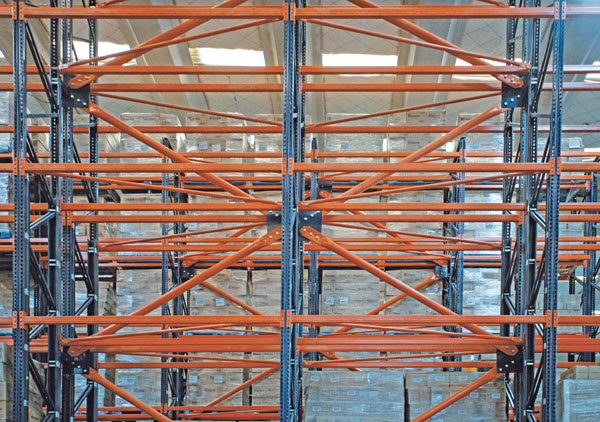Chile is one of the most earthquake prone countries in the world due to its geographical location in the Circum-Pacific belt (also known as the Ring of Fire), the scene of intense seismic activity. It also presents unique characteristics, making it ideal for scientific research related to this natural phenomenon. Accordingly, Mecalux has spent years analysing and improving the structural behavior of racking.

A very extensive portion of mainland Chile is on the South American Plate, where it converges with the edge of the Nazca Plate. The first is moving westwards and the second (which is denser), in the opposite direction. In turn, the Nazca Plate is subductive, i.e. it is embedded below the South American one and advances up to 79 mm per year, generating an accumulation of energy being released and transformed into earthquakes.
Mecalux has operated in this country since 1998 and at all times has guaranteed its customers a product where safety is the highest priority. For that reason, it supplies racks with anti-seismic systems that comply with the rigorous Chilean NCH 2369 standard, with a commitment to build tremor resilient projects.
This standard establishes requirements for the seismic design of structures and industrial facilities, whether light or heavy-duty.
It is a compilation of all international legislation on seismic activity, but applied to real life in Chile. Notably, it is continually reviewed, based on the study of each new earthquake.
Earthquake-proof racking
In Chile, seismic activity is a fact of life that strikes every so often, and something the storage system supplier takes into account in the structural design of racks. Mecalux racks are resistant to earthquake tremors due to:

- Top-level engineering that meets current regulations in Chile and worldwide (by using highly-sophisticated software).
- Quality materials that comply with international manufacturing standards in all Mecalux production centres.
- Constant technological innovation applied to the design of the company's products.
- Usage of structural calculation programmes based on simulations.
With these tools, not only does Mecalux seek to anticipate and ensure optimal performance of structures during seismic activity, but also to develop and optimise the technologies used to manufacture materials. This effort aims to provide customers with high-quality products and the most appropriate solutions at an affordable cost.
Current standards
It differs from building regulations, especially in the calculation of seismic design spectrum and deformation parameters. In addition, specifically for cold-rolled profiles, the NCH 2369 is complemented by the AISI North American standard, AISC and ASTM.
Simulation
In practice, when performing the structural simulation of a particular storage project, building regulation parameters are incorporated, as well as the size of the site, the design configuration of what the customer requires according to its operations, and the type of product to be stored (types of pallets, dimensions, weight, etc.).
The result is a very accurate assessment so that the customer knows the actual cost of their future investment, taking into account all the variables.
The structural simulation during an earthquake is of vital importance from an economic, safety and operational continuity point of view. Not only does one have to ensure the integrity of structures and the products stored in them, but, above all, the lives of people working there.
Structural calculations and verifications
Once the review of the design is performed, it will be certified by an expert.The greater the experience and professionalism of the storage systems supplier, the easier the process of verification by the reviewing engineers.
Structural calculations combine all forces interacting with the racks to determine strains and deformations
Success stories
Mecalux has constructed numerous warehouses in Chile. They are reinforced and set up to protect operators and merchandise against earthquake tremors.
Here are some examples of prestigious companies that have trusted the professionalism of Mecalux when equipping their warehouses with the most advanced solutions on the market:
Iron Mountain
In February 2010, an 8.8 magnitude earthquake struck Chile, with devastating consequences that forced a state of disaster to be declared. Five months earlier, the company Iron Mountain, a leader in information management solutions, appointed Mecalux to construct a large facility with a capacity for more than 1.4 million boxes.
After the seismic event, the company lost seven of its installations supplied by other racking manufacturers, but the Mecalux warehouse withstood the quake.
As a result, Iron Mountain contracted Mecalux to build two more warehouses and reconstruct the multiple facilities that had collapsed.
The land on which the Iron Mountain warehouse is constructed is classified as type 3, the most challenging to develop an earthquake-proof design for this installation
Unilever
Unilever, a consumer products supplier, needed to expand and improve the storage capacity of its distribution centre, as well as increase the seismic resiliency of its structures. It requested the collaboration of Mecalux to calculate, design and commission one of its biggest expansion projects.
Improvement of the structures was carried out by adapting the seismic support of the original installation (built in 2002) to the NCh 2369 standard, approved a year later. For Unilever, safety is a priority and, in that sense, any problem, however small, should be anticipated and dealt with.

As a result, it was possible to optimise and increase the storage capacity, using some materials from the existing structure, adding new racks and modifying the distribution. All this without stopping warehouse operations, keeping up the incoming and outgoing flows of pallets, as well as order prep tasks.
Bodenor (Kimberly-Clark)
After the 2010 quake, the logistics operator Bodenor contracted Mecalux in the supply a new warehouse for its customer Kimberly-Clark, maker of personal hygiene products.
The installation of Kimberly-Clark consists of drive-in racking, with a capacity for more than 13,000 pallets.

Bodenor decided to use Mecalux racking due to the high level of technology applied in its manufacturing, the raw materials used, as well as the painting, finishing and the assembly process.

